KMail/Backup Options/de: Difference between revisions
Created page with "Sie können das Ankreuzfeld links von jedem Eintrag in der Liste verwenden um die Aufträge zu aktivieren oder deaktivieren." |
Created page with "Mit dem Kontextmenü, das mit der rechten Maustaste auf einem Archivierungsaufrag aufgerufen wird, können Sie den Ordner öffnen, in dem das Archiv abgelegt ist. Sie können..." |
||
| Line 54: | Line 54: | ||
Sie können das Ankreuzfeld links von jedem Eintrag in der Liste verwenden um die Aufträge zu aktivieren oder deaktivieren. | Sie können das Ankreuzfeld links von jedem Eintrag in der Liste verwenden um die Aufträge zu aktivieren oder deaktivieren. | ||
Mit dem Kontextmenü, das mit der rechten Maustaste auf einem Archivierungsaufrag aufgerufen wird, können Sie den Ordner öffnen, in dem das Archiv abgelegt ist. Sie können auf einen Archiverungsauftrag direkt über das Kontextmenü starten. | |||
{{Warning|This will overwrite an existing archive created earlier at the same day without notification.}} | {{Warning|This will overwrite an existing archive created earlier at the same day without notification.}} | ||
Revision as of 18:24, 8 October 2020
Sicherungsmöglichkeiten
Es gibt mehrere Sicherungsmöglichkeiten in KMail, der E-Mail-Anwendung von KDE.
Manuelle Archivierung
- →
Alternativ über das Kontextmenü, das mit der rechten Maustaste aufgerufen wird. Wählen Sie hier . Es öffnet sich eine Dialogbox über die es möglich ist ein einzelnen Archiv für den ausgewählten Ordner zu erstellen. Der Name des Archivs besteht aus dem Vorspann Archiv_, dem Namen des Ordners, das Datum im Format Jahr--Monat--Tag und der entsprechenden Dateiendung (z. B. . Archive_Inbox_2013-09-03.tar.bz2).
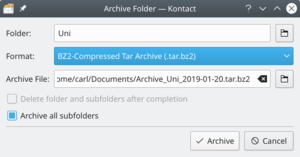
Das Textfeld Ordner zeigt den aktuell zur Archivierung ausgewählten Ordner. Falls Sie einen anderen Ordner archivieren möchten, klicken Sie bitte auf das ![]() Symbol rechts.
Symbol rechts.
Das Auswahlfeld ermöglicht es das Format des Archives zu bestimmen (z. B. zip, tar, tar.bz2, and tar.gz).
Wenn Sie die Standardvorgaben für den Namen oder den Speicherort des Archivs ändern möchten, klicken Sie bitte auf das ![]() Symbol am Ende der Zeile mit .
Symbol am Ende der Zeile mit .
Aktivieren Sie die Option , wenn Sie möchten, dass alles was Sie archiviert haben gelöscht wird.
Standardmäßig werden alle Unterordner mit archiviert. Um dieses zu ändern entfernen Sie den Harken bei , wenn Sie nur den Hauptordner archivieren möchten.
Automatische Archivierung
- →
Seit KDE 4.12 können Sie einstellen, dass ein KMail-Ordner automatisch archiviert wird.
Das ist ein mächtiges Werkzeug, dass ihnen hilft ihre Archivierung zu automatisieren. Der Name des Archivs besteht aus dem Vorspann Archiv_, dem Namen des gewählten Ordners, das Datum in dem Format Jahr--Monat--Tag und der entsprechenden Dateiendung (z. B. Archive_(Local Folder)_inbox_2013-09-03.tar.bz2).
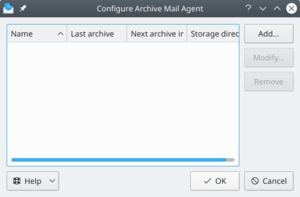
Um die zu archivierenden Ordner auszuwählen, klicken Sie bitte zuerst auf .
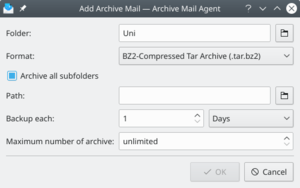
Wählen Sie das Format in dem Sie das Archiv speichern möchten (z. B. .tar.bz2) aus dem Auswahlfeld.
Standardmäßig ist die Option ausgewählt. Entfernen Sie diese Auswahl, wenn wie nur den Hauptordner archivieren möchten.
Sie können den Pfad in dem das Archiv gespeichert werden soll manuell eingeben oder den Ordner über einen Klick auf den ![]() Knopf (Dateiauswahl öffnen) auswählen.
Knopf (Dateiauswahl öffnen) auswählen.
Wählen Sie über das Auswahlfeld neben in welchen Abständen die Archivierung durchgeführt werden soll.
- Wenn ihr Platz auf dem Laufwerk begrenzt ist, dann werden Sie die maximale Anzahl an Archiven begrenzen wollen.
- Wenn Sie einen Archivierungsauftrag neu hinzugefügt oder verändert haben, dann wird der Auftrag sofort nach Schließen des Dialogs ausgeführt.
- Wenn Sie bereits Achivierungsaufträge hinzugefügt haben, dann werden diese im E-Mail-Archivierung einrichten - Agent zur E-Mail-Archivierung-Fenster aufgelistet und Sie können Sie hier ändern.
Sie können das Ankreuzfeld links von jedem Eintrag in der Liste verwenden um die Aufträge zu aktivieren oder deaktivieren.
Mit dem Kontextmenü, das mit der rechten Maustaste auf einem Archivierungsaufrag aufgerufen wird, können Sie den Ordner öffnen, in dem das Archiv abgelegt ist. Sie können auf einen Archiverungsauftrag direkt über das Kontextmenü starten.
This feature allows you to archive single emails to a specified folder.
For instance, you need to archive all of those pesky bill receipts in one place. Folder Archive Agent can easily accommodate those needs.
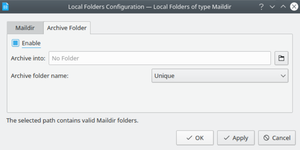
This dialog will have a tab for each of your configured accounts including Local Folders and you will need to configure all accounts that you wish to use this feature with.
The first option allows you to enable/disable the folder archive agent. It is disabled by default, to enable check the check box.
You can set the location of your Archive folder by clicking the ![]() icon next to and selecting the folder you wish to use.
icon next to and selecting the folder you wish to use.
For example, you could create a folder called “bill receipts” by clicking the and typing bill receipts in the dialog. You may choose a folder location anywhere, e.g... a folder in your Local Folders or on your IMAP server.
You have several choices on how the emails will be archived:
- - Uses the selected folder sorted by date.
- - Creates new folders inside the selected folder by months.
- - Creates new folders inside the selected folder by years.
Now when you receive a bill receipt, right mouse button the email and select from the menu. The email will be archived into your configured archive folder for easy viewing later on.
Exporting
Or pimsettingexporter can be run as a standalone application by running pimsettingexporter in the application launcher.
This feature exports settings and local mail to a compressed file.
Backing up is an essential practice for all users. PIM Setting Exporter is a great tool for backing up or moving all of your settings and email to a new installation. You also use PIM Setting Exporter to import previous backups.
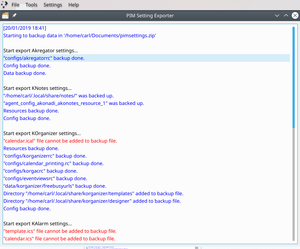
To perform a backup, select , it will prompt you to close all kdepim applications.
Once you have closed them, click to continue, or to cancel.
You will be prompted to create a backup name, enter the name into the textbox, e.g. mymailsettings.
The default file type it saves as is .zip, if you want a different type, deselect and append the extension to the end of your file name.
The next screen will allow you to select what you wish to backup, by default everything is selected.
The final screen shows the log of the backup process. You can close the window once you have reviewed the log and verified your backup was successful.
To restore your backup, select within pimsettingexporter.


